Customer Experience vs Customer Service: The Real Difference
Customer service is just one small piece of the puzzle called customer journey, which drastically impacts the overall customer experience. In that sense, they aren’t just closely intertwined but share a deeply correlative existence.
On this page
As our earlier blog dealt with the basics of customer experience, this guide embarks clearly upon differentiating between customer experience and customer service, what are the metrics of customer experience and how to measure them - along with some of the best examples of customer experiences all across the globe to upend your learning.
In the entire lexicon of business, there are hardly any other terms than customer service and customer experience that have been used interchangeably - both by the bonafide experts and laymen.
The intermittence stems from their overarching overlapping in each other’s functions. But the fact is, there is a line of difference between the two, however thin it may be. And it begins with the definition of customer service itself.
What is Customer Service?
As the definition suggests, customer service strictly pertains to a single function of customer support. Its essence lies in providing assistance and advice to a customer for your product or service as needed pre or post-sale.
Unlike customer experience, customer service operates isolatedly and involves customer-facing departments, such as voice-over IP or employees in physical stores.
Though it typically involves human touch with brands, artificial intelligence's rapid proliferation has marked its peak in customer service. The increasing use of AI chatbots to answer FAQs and tackle initial inquiries is a case in point.
In short, customer service is just one small piece of the puzzle called customer journey, which drastically impacts the overall customer experience. In that sense, they aren’t just closely intertwined but share a deeply correlative existence.
You cannot have a riveting customer experience without stout customer service, and customer service loses its purpose if it fails to elevate the customer experience. They both are, thus, equally important.
Customer Experience vs Customer Service: What differentiates them?
In simple words, customer service is only a part of the customer journey, whereas customer experience involves all the interactions between a customer and a brand.
Both customer experience and customer service are vital factors for an organization’s success, yet it is hard to draw lines between them. The difference between how consumers use a product and how they communicate with other consumers supporting it is blurred.
With that being said, let’s dive deep into understanding both of them better.
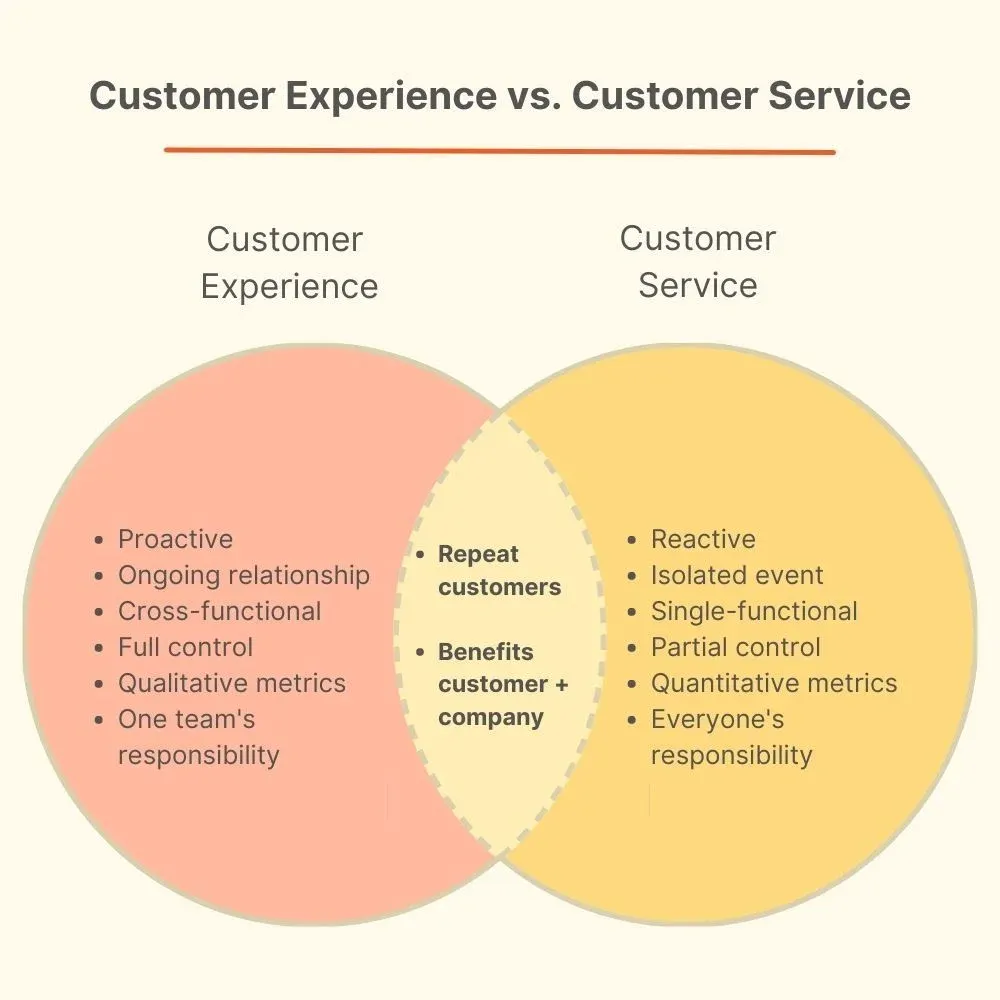
Apart from the external “entire VS specific interaction,” a line of separation runs long and deep.
1. Proactive vs. reactive
- The very breath of customer experience is foreseeing the needs and pains of customers and making provisions accordingly. Businesses try to do that by devising an incremental cycle of the improved customer experience through detailed customer journey mapping, understanding of funnel drop-off points, and collecting thorough customer feedback. In this sense, an ideal customer experience is always proactive.
- More or less, customer service gets initiated by the customer. After an unpleasant face-off with friction, customers reach out to business support services via multitudes of channels (phone, email, social media, or live chat.) Customer service, in this context, is reactive.
2. Ongoing relationship vs isolated event
- Customer experience is a measurement of the quality of your customer’s relationship with your business. It cannot be, therefore, pigeonholed to one single interaction. Customer experience is an ongoing relationship - and it only ends when customers decide to move out permanently.
- Customer service is related to a specific and isolated event, i.e., a customer is complaining about a non-working dashboard of your app. Since it’s more transactional, it gets measured by a number of metrics, first-time resolution rate, average response time are just a few to name.
3. Full control vs partial control
- Customer experience is too vast, an amalgamation of all the conceivable and inconceivable avenues of communication, experiences, brand perceptions, and market upheavals. Since some of these elements are unpredictable, you may be bereft of ironclad control over the task of weaving up the ideal version of envisioned customer experience.
- Customer service, including the channel of communication and level of grievance, is fully visualized and implemented by you. You can slot them into categories as per the level of their gravity, deploy teams accordingly by viewing their level of specialization, and quantify how many queries got resolved. It implies the possibility of cruise control - particularly when operating at the most efficient level.
4. Qualitative vs quantitative metrics
- Customer experience is a quintessentially experiential and emotional entity. However, there are certain metrics like customer lifetime value (CLV), customer churn rate, customer retention rate, which can be strongly indicative of its quality.
- Since customer service is reactive, it’s comparatively easy to measure how quickly and regularly you responded, how many queries you solved, and the level of customer satisfaction after every interaction. Customer satisfaction score (CSAT), customer effort score (CES), and Net Promoter Score (NPS) are, therefore, prime indicators of the quality of customer service.
5. One team’s responsibility vs everyone’s responsibility
- Customer experience is what a customer thinks, feels, remembers, and talks about your company. With hundreds of touchpoints facilitating the interaction with your company, that too at multiple levels, maintaining a worthy customer experience is the responsibility of everyone in the organization, starting from the product team to the delivery people.
- Customer service is mainly the responsibility of the customer support team. Other teams may interact with customers for various procedural compulsions. But it’s the customer support team that is responsible for helping the customers in times of trouble.
How to Measure Customer Experience Thoroughly?
Despite agreeing with what Ed Thompson says, measurement of customer experience is a topic fraught with challenges. It’s understandable as it involves multiple touchpoints, traversing different channels with different objectives. Naturally, it becomes difficult to know what’s working and what’s not.
Nielsen mentions that measurable results might be good indicators to see the vitality of customer experience. But that same research also found that 80% of customer experience designers don’t use metrics.
Why such a discrepancy? It’s generally because adding metrics to your long, convoluted customer journey adds complexity to an already challenging task. The solution, then, is a three-step model to gather metrics for your customer journey.
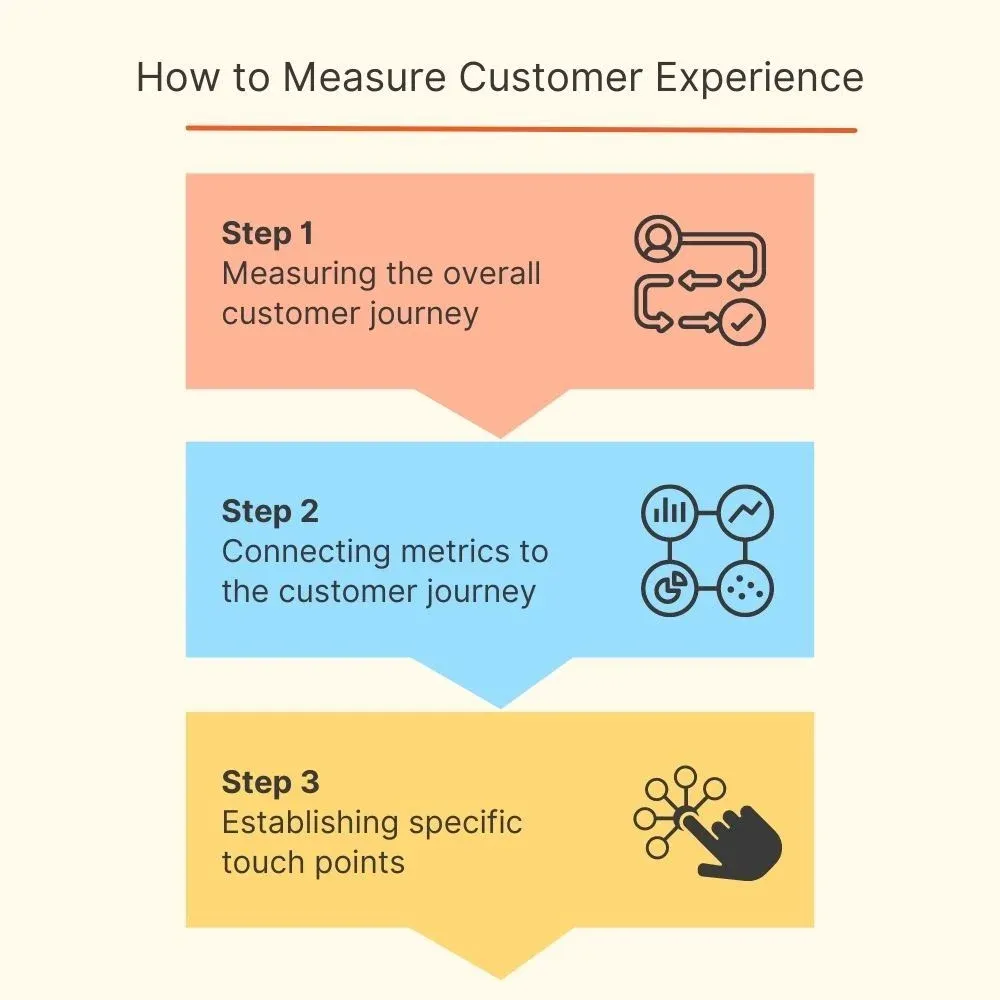
Step 1: Measuring overall customer journey
Since overall measurement gives a complete picture of efficiency, this stage and metric will be your ultimate measure of customer experience success.
After surveying 27,000 consumers, McKinsey stated that measuring the overall journey was a far superior indicator of an effective experience than measuring touchpoints.
As it noted: A company’s performance on journeys is 35% more predictive of customer satisfaction and 32 percent more predictive of customer churn than performance on individual touchpoints.
The most commonly used metrics for measuring the overall customer experience include:
- Net Promoter Score (NPS)
- Customer Effort Score (CES)
- Customer Satisfaction (CSAT)
Let’s grasp their skin.
1. Net Promoter Score (NPS)
NPS is a criterion that measures customer loyalty, satisfaction, and enthusiasm with a company by asking customers one question: “On a scale from 0 to 10, how likely are you to recommend this product/company to a friend or colleague?”
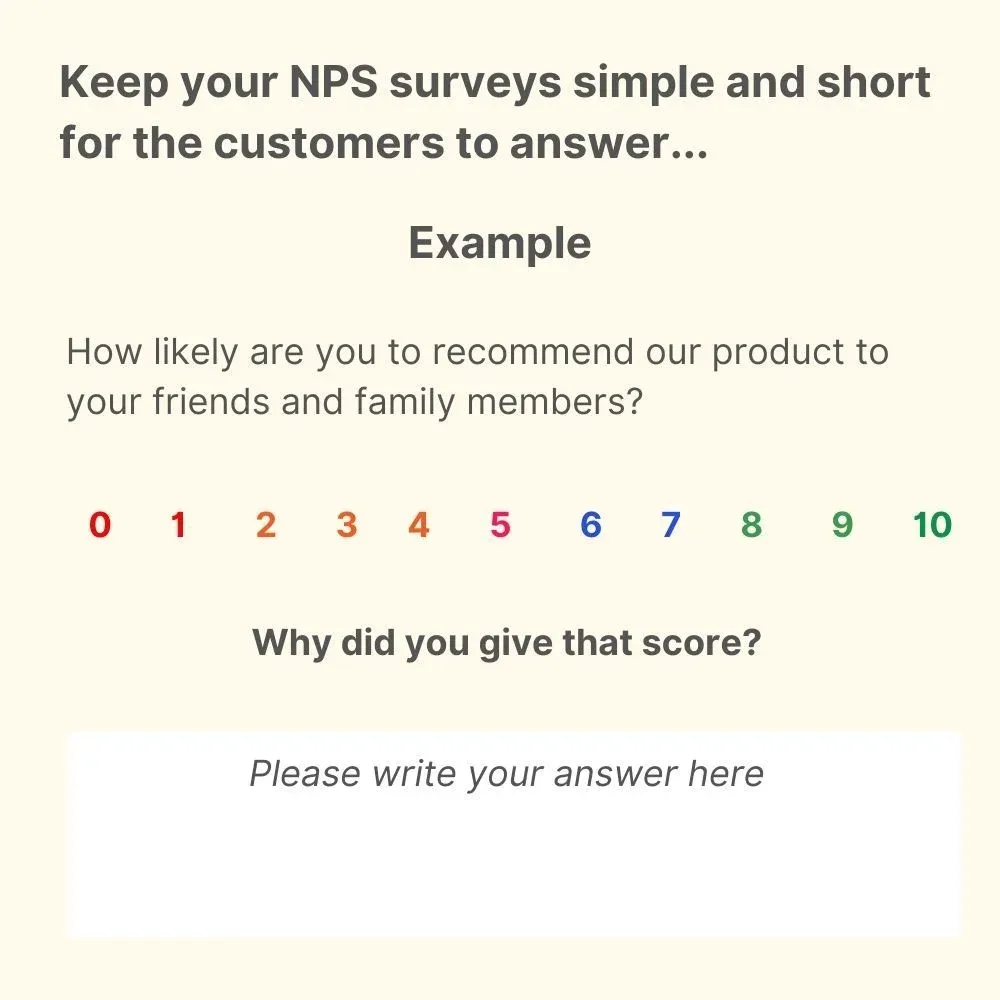
NPS, in general, gives you a customer experience-related number that you need for improving services, support systems, and post-sale handlings. NPS is widely used to rate a brand, service, or product.
How to calculate NPS?
- Calculate the percentage of promoters from your surveyed customers.
- Calculate the percentage of detractors.
- Subtract the detractor percentage from the promoter percentage.
Why is NPS important?
Though NPS fairly indicates the quality of the relationship you have with your customers, no number alone, in general, is enough to paint a complete picture of your customer experience. The NPS system as a whole is extremely crucial because it allows businesses:
- Dig deep through follow-up questions as part of the NPS survey. By asking customers the rationale behind the specific score they give to organizations, organizations can accurately pinpoint the areas for improvement.
- Keep an eye on the quality and quantity of scores over time, helping in establishing internal benchmarks.
- Infuse all the employees with one mission: Earning and retaining more customers through exemplary customer experience and service.
2. Customer Satisfaction (CSAT)
The CSAT denotes what it expresses on the tin: it measures the satisfaction level of customers with your business. One of the most straightforward methods of quantifying satisfaction, it can take into consideration the one particular touchpoint along the customer journey or with your brand as a whole.
The CSAT is based on a single question that indicates how close you are to meeting your customers’ expectations, such as:
How would you rate your overall satisfaction with the product(s)/service(s) you received from Company X?
- Very unsatisfied
- Unsatisfied
- Neutral
- Satisfied
- Very satisfied
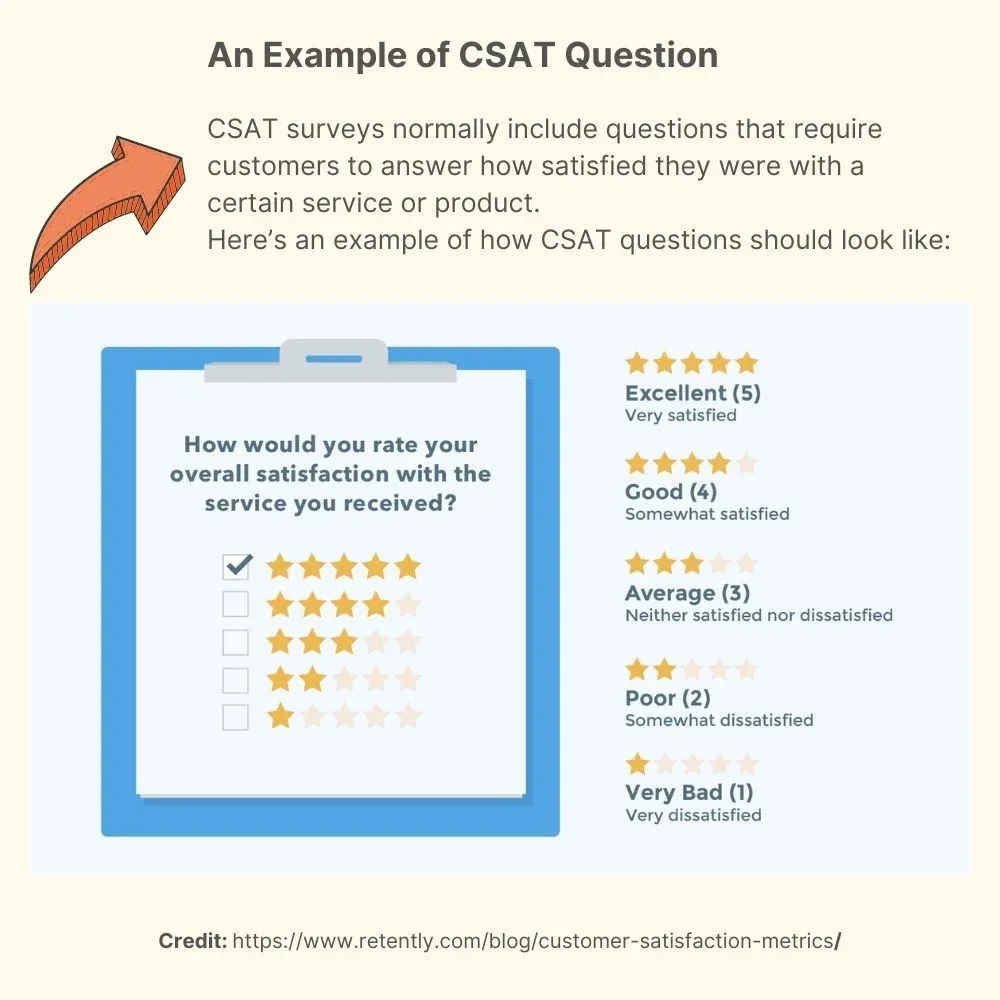
Note that CSAT surveys aren’t always limited to a single question. You can customize multiple open-ended and closed-ended questions in the same survey to suit your need – like the Hilton Hotels chain does.
How to calculate CSAT?
CSAT singularly defines the percentage of happy customers. While doing this calculation, only "Very satisfied" and "Satisfied" responses are included. You have to divide the number of satisfied customers by the total number of survey responses and multiply that figure by 100.
Why is CSAT important?
The real authentication of great customer experience comes from genuine customer satisfaction, and satisfaction weaves up enduring magic—just a 10% increase in a company’s CSAT score leads to a 12% increase in trust from customers.
Research has proved that enhancing satisfaction throughout the customer journey positively impacts customer satisfaction by 20%, boosts revenue by up to 15%, and lowers the cost of serving customers by 20%.
Moreover, the CSAT method offers other benefits:
- It’s short, interactive, and easy to use.
- The rating scale and types can be customized as per the context, allowing you to use stars, emojis, or numeric rating scales that go with your overall branding.
- As it doesn’t eat up a lot of time and attention from customers due to the fewer questions, CSAT ensures higher response rates than its contemporaries.
3. Customer Effort Score (CES)
A customer effort score (CES) is a metric that measures the efforts customers exert for initiating interactions with your business.
These interactions include the efforts customers take to use your product, how easy it was to find the related information on your website, and how easy it was to get the problem solved by your service reps.
In short, rather than measuring the overall customer experience, CES measures the ease of customer interaction and experience by asking simple operative and functional questions like:
How to calculate CES?
CES is calculated by dividing total customer effort scores by the total number of survey responses. It gives you an average amount of effort your customers are putting in while interacting with your business.
The goal of the CSAT metric, then, is to give you specific and actionable insights about the areas that need drastic improvement. If your reports suggest that customers are putting a lot of effort into raising a complaint ticket, you know where the ailment is and what needs to be done.
Why is CES important?
By default, man is a pleasure-loving animal. The moment he encounters a high-learning curve or grueling friction in a task, he is consumed by the strong sense of abhorrence for it.
This truth of human nature was at the crux of an HBR article entitled Stop Trying to Delight Your Customers, which supposedly gave rise to the popularity of CES as a metric.
Its findings were unusual for that time: The simple way to increase customer loyalty is not through wowing your customers - but through making it easier for them to do what they want to do.
The article summarized this learning cogently by saying:
"When it comes to service, companies create loyal customers primarily by helping them solve their problems quickly and easily."
The verdict: Which metric best measures the overall customer experience?
It’s a matter of debate, as various experts have put their weight behind different metrics.
Gartner believes that CES outperforms NPS and CSAT in predicting customer repurchase and increased spending, as the following chart shows.
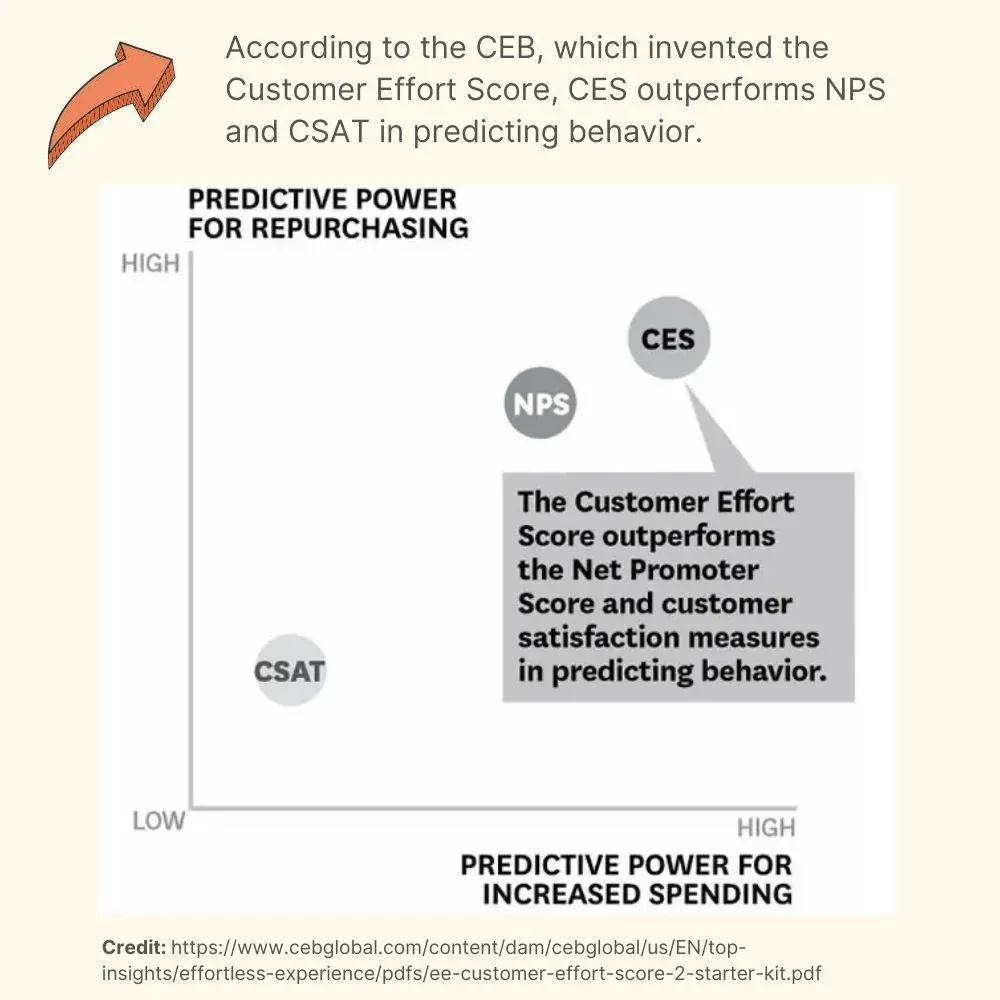
McKinsey, on the other hand, describes the importance of customer satisfaction (CSAT): Maximizing satisfaction with customer journeys has the potential not only to increase customer satisfaction by 20% but also to lift revenue by up to 15%.
Clearly, all the metrics blow hot and cold on various key pointers. It’s, therefore, advisable to track all of them to have a complete picture of the effectiveness of your customer experience.
Step 2: Connect metrics to the customer journey
Since customer journeys differ with products and various purchase stages, metrics utilized to measure the effectiveness of each stage also differ. The critical question, then, is: Does each stage of our journey perform its main goal?”
Awareness:
- Key question: Do customers know your brand, products, and product features?
- Metrics to measure: Share of Voice in the market, total visits to your website
Consideration:
- Key question: When customers have decided to buy, are they thinking about you?
- Metrics to measure: Organic keyword traffic revolving around your product, retail store footfall
Purchase:
- Key question: Once customers set out on a buying process, do they complete the purchases?
- Metrics to measure: Abandoned basket/cart rates, footfall in stores vs. purchases
Retention:
- Key question: Are existing customers returning to shop with you again?
- Metrics to measure: Customer Lifetime Value (CLV), repeat purchase rate, order value, customer service ticket volume
Advocacy:
- Key question: Are your customers ready to recommend you to others?
- Metrics to measure: Net promoter score (NPS), sentiments on social media, referral numbers.
Step 3: Establish specific touchpoint metrics
The critical question in this step is: “Do your touchpoints remove friction and make customers happy?”
Physical touchpoint metrics examples:
- Retail store: Total footfall vs. actual number of purchases, cart size, sales in retail, number of queries.
- Retail point of purchase communications (POP): Sales uplift of products, overall sales uplift, halo effect on sales
Digital touchpoint metrics examples:
- eCommerce website: Uptime, total drop-off points, bounce rate, loading speed, mobile page performance, stay time.
- Online chat support: Length of support chat, customer satisfaction after the support chat, repeat purchase, waiting time, customer sentiments in chats
Note that all touchpoint metrics don’t have an equal impact on the overall customer experience. Some touchpoints, like posters, may need one metric to see if they’re working or not. Some critical touchpoints, like websites, may demand more than one metric.
Knowing which touchpoints are more important and how they affect customer experience, thus, is of vital importance. Peak-end Rule can be a guiding light in this context.
The Peak-end Rule: A behavioral science principle that can transform your customer experience.
The Peak-end Rule affirms that people finally judge an experience on how they feel at its peak and its end as opposed to the average of every moment of the experience. Whether the experience was good or bad, this holds true.
It unequivocally implies that customers will remember their whole experience with a brand based on only two moments: the best or worst part of the experience and the end.
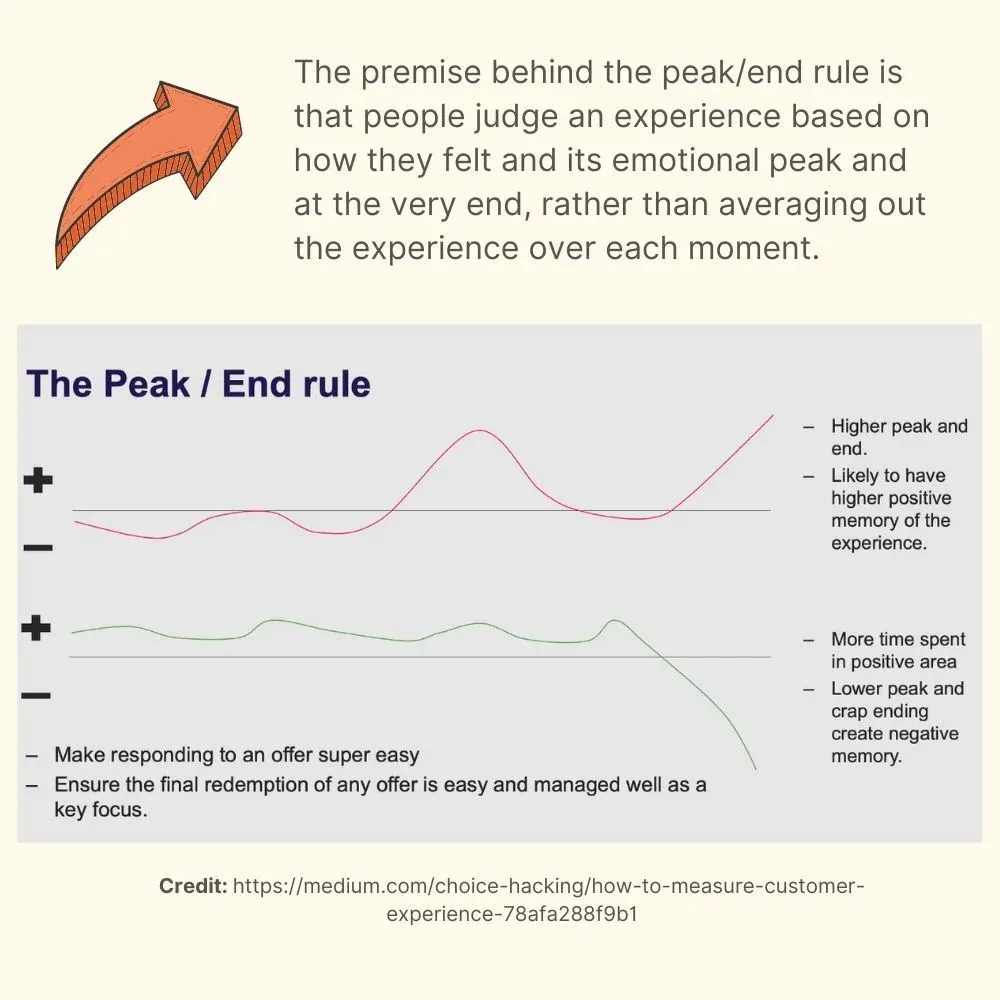
Caution: Without context, metrics mean nothing
Looking at how vulnerable numbers are to misinterpretation, metrics can be highly deceiving. If they have to make any sense, they need to be mounted in the right context. Dwell-time on a website is a classic example of this misinterpretation.
It’s easy to believe that dwell-time means customers are enjoying your website experience and are pleasantly hooked to it. However, in reality, they may be clueless about your website’s navigation and are feeling like getting lost in a cave.
The only solution is to infuse qualitative scrutiny like observational studies into quantitative data to comprehend the “why” behind every “what.”
Examples of Good Customer Experience
Now equipped with the actual meaning of customer experiences, the right metrics to measure it, and conclusive proof of why they are important, the next logical extension is to seriously flip through the examples that embodied the customer experience like never before and learn from them.
This steady decanting of learning will act as a walking-talking guide to your endeavors of crafting a memorable customer experience. After all, everything cannot be taught, but everything can be learned.
1. JetBlue: When as small as coffee became a big tool of customer satisfaction
When Paul Brown was flying through JetBlue airlines, and the hardcore coffee addict in him realized that it’s hard to grab his Starbucks coffee before boarding the plane because of the smaller terminal, he casually tweeted about it.
Within minutes of the tweet, JetBlue jumped to action, and the airport customer service representative handed over a tasty and creamy Starbucks venti mocha to his seat on the plane.
Not to mention, Brown was more than elated - not because he finally got to sip his favorite coffee. But because the experience came when it was least expected.

📚 Key learning: This particular example is very much in accordance with the HBR article that we discussed earlier. The best way to satisfy customers and earn loyalty is to help them when they are in distress or facing trouble, however tiny those troubles may be.
First and foremost, it ensures your level of appreciation and value for the customer - the fulcrum of customer retention. And you don’t always have to put a heap of coins in it.
A small gesture, as small as a coffee cup, can warm your customers’ towards you - that too irrevocably. After this warm experience, it would be very hard for Mr. Brown to think about any other airlines - and that’s what a truly great customer experience does: it stays with you.
2. Trader Joe’s: Going out of way generally lands you into the customer’s hearts
We all go through a lot every day, and that grinding may get reflected in customers. The grumpy, sullen look is indicative of that. And it can severely escalate if children add to the troubles.
Trader Joe’s knew it well. When its employees saw that the toddler was seriously unhappy about something and was throwing tantrums, they broke into singing and dancing to hush the toddler playfully, giving rise to only one question: Who with naughty children wouldn’t appreciate this wonderful gesture by these employees?
📚 Key learning: Be mindful of the customers who aren’t having the best day and are feeling a little low. Find some little gestures and ways to cheer them up. They may forget what they had bought from you, but not how you brought a smile on their faces when they were forlorn.
3. The Ritz-Carlton Hotel Company: Turning customer errors into experience possibilities
Ritz-Carlton allows its employees up to $2,000 to fix any guest problem, with no further questioning.
One example is John DiJulius, who left his charger behind at The Ritz-Carlton Sarasota. He got a next-day air package with his charger and a note announcing: ‘Mr. DiJulius, I wanted to make sure we got this to you right away. I am sure you need it, and, just in case, I sent you an extra charger for your laptop.’
📚 Key learning: A little lapse or misplacement from customers is a great opportunity to win the customer permanently, provided you go above and beyond. You must foresee the trouble that customers might end up in for their lapses - and try to save them from it by proactive intervention.
4. Casper: Connecting customer experience to customer well-being
From being unable to sleep peacefully to insomnia, sleep-related problems are on the rise. Add to it the dread of loneliness, and the simple act of sleeping sometimes can be a horrible ordeal.
Casper, the ship-to-your-home king-size mattress maker, understood it and decided to make it a focal point of customer experience. Along with hosting conversations revolving around getting asleep within 40 winks, Casper developed a free chatbot specifically for insomniacs.
Customers can simply text “Insomnobot3000” from their mobile phones and say whatever comes from the heart, and the robot will have a real conversation with them between 11 PM to 5 AM.
Clearly, more than delivering a mere product, Casper was delivering product-related well-being through customer experience.
The element of care shone more brightly than a diamond. One shouldn’t be surprised to know that Casper generated more than $100 million in sales within the 1st year of the chatbot’s launch.
📚 Key learning: Deepen the human element in your customer experience as much as possible. Always be on the hunt to find ways of connecting your communication, service paraphernalia with the overall well-being of a customer.
No customer should be a mere account number for you. Like you, he is also made up of bones, flesh, and sentiments.


















